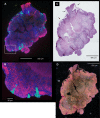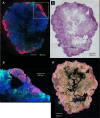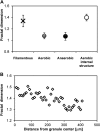Aerobic granules: microbial landscape and architecture, stages, and practical implications
- PMID: 24657859
- PMCID: PMC4018849
- DOI: 10.1128/AEM.00250-14
Aerobic granules: microbial landscape and architecture, stages, and practical implications
Abstract
For the successful application of aerobic granules in wastewater treatment, granules containing an appropriate microbial assembly able to remove contaminants should be retained and propagated within the reactor. To manipulate and/or optimize this process, a good understanding of the formation and dynamic architecture of the granules is desirable. Models of granules often assume a spherical shape with an outer layer and an inner core, but limited information is available regarding the extent of deviations from such assumptions. We report on new imaging approaches to gain detailed insights into the structural characteristics of aerobic granules. Our approach stained all components of the granule to obtain a high quality contrast in the images; hence limitations due to thresholding in the image analysis were overcome. A three-dimensional reconstruction of the granular structure was obtained that revealed the mesoscopic impression of the cavernlike interior of the structure, showing channels and dead-end paths in detail. In "old" granules, large cavities allowed for the irrigation and growth of dense microbial colonies along the path of the channels. Hence, in some areas, paradoxically higher biomass content was observed in the inner part of the granule compared to the outer part. Microbial clusters "rooting" from the interior of the mature granule structure indicate that granules mainly grow via biomass outgrowth and not by aggregation of small particles. We identify and discuss phenomena contributing to the life cycle of aerobic granules. With our approach, volumetric tetrahedral grids are generated that may be used to validate complex models of granule formation.
Figures








Similar articles
-
Microbial dynamics and properties of aerobic granules developed in a laboratory-scale sequencing batch reactor with an intermediate filamentous bulking stage.Appl Microbiol Biotechnol. 2016 Jan;100(1):447-60. doi: 10.1007/s00253-015-6981-7. Epub 2015 Sep 22. Appl Microbiol Biotechnol. 2016. PMID: 26394861
-
Biomass and porosity profiles in microbial granules used for aerobic wastewater treatment.Lett Appl Microbiol. 2003;36(5):297-301. doi: 10.1046/j.1472-765x.2003.01312.x. Lett Appl Microbiol. 2003. PMID: 12680942
-
Characteristics and performance of aerobic algae-bacteria granular consortia in a photo-sequencing batch reactor.J Hazard Mater. 2018 May 5;349:135-142. doi: 10.1016/j.jhazmat.2018.01.059. Epub 2018 Feb 2. J Hazard Mater. 2018. PMID: 29414745
-
Aerobic granular sludge: characterization, mechanism of granulation and application to wastewater treatment.Crit Rev Biotechnol. 2011 Jun;31(2):137-52. doi: 10.3109/07388551.2010.497961. Epub 2010 Oct 4. Crit Rev Biotechnol. 2011. PMID: 20919817 Review.
-
Microbial community structure and function in aerobic granular sludge.Appl Microbiol Biotechnol. 2018 May;102(9):3967-3979. doi: 10.1007/s00253-018-8905-9. Epub 2018 Mar 17. Appl Microbiol Biotechnol. 2018. PMID: 29550989 Review.
Cited by
-
The mechanisms of granulation of activated sludge in wastewater treatment, its optimization, and impact on effluent quality.Appl Microbiol Biotechnol. 2018 Jun;102(12):5005-5020. doi: 10.1007/s00253-018-8990-9. Epub 2018 Apr 28. Appl Microbiol Biotechnol. 2018. PMID: 29705957 Free PMC article. Review.
-
How sample heterogeneity can obscure the signal of microbial interactions.ISME J. 2019 Nov;13(11):2639-2646. doi: 10.1038/s41396-019-0463-3. Epub 2019 Jun 27. ISME J. 2019. PMID: 31249391 Free PMC article. Review.
-
Optimized aeration strategies for nitrogen removal efficiency: application of end gas recirculation aeration in the fixed bed biofilm reactor.Environ Sci Pollut Res Int. 2019 Sep;26(27):28216-28227. doi: 10.1007/s11356-019-06050-9. Epub 2019 Jul 31. Environ Sci Pollut Res Int. 2019. PMID: 31368074
-
Comparison of the bacterial community composition in the granular and the suspended phase of sequencing batch reactors.AMB Express. 2017 Sep 5;7(1):168. doi: 10.1186/s13568-017-0471-5. AMB Express. 2017. PMID: 28871435 Free PMC article.
-
Recent advancements in the biological treatment of high strength ammonia wastewater.World J Microbiol Biotechnol. 2021 Aug 22;37(9):158. doi: 10.1007/s11274-021-03124-0. World J Microbiol Biotechnol. 2021. PMID: 34420110 Review.
References
-
- Lettinga G, Vanvelsen AFM, Hobma SW, Dezeeuw W, Klapwijk A. 1980. Use of the upflow sludge blanket (Usb) reactor concept for biological wastewater treatment, especially for anaerobic treatment. Biotechnol. Bioeng. 22:699–734. 10.1002/bit.260220402 - DOI
-
- de Mes TZD, Stams AJM, Reith JH, Zeeman G. 2003. Methane production by anaerobic digestion of wastewater and solid wastes, p 58–95 In Reith JH, Wijffels RH, Barten H. (ed), Bio-methane and bio-hydrogen: status and perspectives of biological methane and hydrogen production. Smiet Offset, The Hague, Netherlands
-
- de Kreuk MK, Kishida N, van Loosdrecht MCM. 2007. Aerobic granular sludge: state of the art. Water Sci. Technol. 55(8-9):75–81 - PubMed
Publication types
MeSH terms
Substances
LinkOut - more resources
Full Text Sources
Other Literature Sources
Molecular Biology Databases

